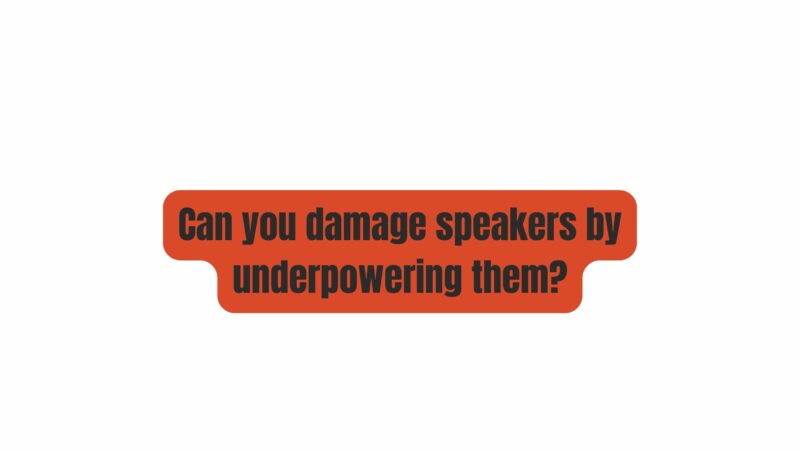When it comes to speaker performance and longevity, much attention is given to overpowering speakers and pushing them to their limits. However, there is another, often overlooked, concern: underpowering. Can underpowering speakers cause damage or harm their performance? In this in-depth article, we’ll explore the concept of underpowering, its potential consequences, and how to strike the right balance between power and speakers to ensure optimal audio quality and protection.
Understanding Underpowering
To grasp the implications of underpowering, let’s begin by defining what it means:
Underpowering refers to the practice of pairing speakers with an amplifier that provides less power (wattage) than the speakers’ recommended or nominal power handling capacity. In essence, it’s when the amplifier is not supplying enough power to drive the speakers effectively.
It’s crucial to distinguish between the terms “underpowering” and “matching.” Underpowering occurs when the amplifier’s power output is significantly lower than what the speakers require, while matching involves selecting an amplifier with a power rating that aligns with the speakers’ needs.
The Potential Consequences of Underpowering
Underpowering speakers can have several negative consequences that affect both the audio quality and the health of your speakers:
- Clipping: When an amplifier lacks the necessary power to drive speakers at their intended levels, it can lead to clipping. Clipping occurs when the amplifier’s output signal attempts to exceed its capacity, resulting in distortion and audio artifacts. Clipping can be especially damaging to high-frequency drivers like tweeters.
- Overheating: Underpowered amplifiers may need to work harder to produce sufficient volume, leading to increased heat generation. Prolonged exposure to high temperatures can damage speaker components, such as voice coils, surrounds, and diaphragms.
- Reduced Dynamic Range: Speakers driven by an underpowered amplifier may struggle to reproduce dynamic audio content accurately. This can result in compressed sound, where soft and loud passages lack the intended contrast and impact.
- Voice Coil Damage: Underpowering can lead to voice coil overheating due to the prolonged application of inadequate power. Overheated voice coils may become distorted, lose their structural integrity, and ultimately fail.
- Loss of Detail and Clarity: Insufficient power can cause speakers to operate outside their optimal performance range, resulting in a loss of detail and clarity in the audio playback.
- Speaker Fatigue: Running speakers at or near their limits for extended periods can lead to fatigue and decreased lifespan. Underpowered speakers may be forced to operate closer to their limits more frequently, increasing the risk of damage over time.
Finding the Right Balance: Matching Power to Speakers
To avoid the potential pitfalls of underpowering, it’s crucial to match the power of your amplifier to the specifications of your speakers effectively. Here are the key steps to achieving the right balance:
- Know Your Speaker’s Specifications: Familiarize yourself with your speakers’ specifications, particularly their nominal or RMS power handling capacity. This rating indicates the amount of continuous power the speakers can handle without damage.
- Choose the Right Amplifier: Select an amplifier whose power rating aligns with the speakers’ nominal power handling capacity. Ideally, the amplifier’s output power should match or slightly exceed the speaker’s rating.
- Consider Amplifier Headroom: While matching the power rating is essential, it’s beneficial to have some amplifier headroom. Headroom provides a buffer for dynamic audio peaks and helps prevent clipping and distortion during challenging passages.
- Impedance Matching: Ensure that the amplifier’s impedance (ohm) rating is compatible with your speakers’ impedance. Mismatched impedance can lead to inefficient power transfer and reduced performance.
- Consult Manufacturer Recommendations: Manufacturers often provide amplifier recommendations for their speakers. These guidelines can serve as valuable references when choosing the right amplifier.
Benefits of Properly Matching Power to Speakers
Matching the power of your amplifier to your speakers offers several significant advantages:
- Optimal Audio Quality: Properly matched components ensure that your speakers receive the right amount of power for clear, distortion-free sound reproduction.
- Protection Against Damage: Avoiding underpowering helps protect your speakers from overheating, voice coil damage, and other issues associated with inadequate power.
- Extended Speaker Lifespan: By providing sufficient power, you can prolong the lifespan of your speakers and reduce the risk of costly replacements.
- Enhanced Dynamic Range: Properly matched systems can faithfully reproduce dynamic audio content with the intended contrast and impact, delivering a more engaging listening experience.
- Reduced Clipping and Distortion: Amplifiers with appropriate power levels are less likely to clip, resulting in cleaner and more accurate sound.
Conclusion
While much attention is given to the potential damage caused by overpowering speakers, it’s essential not to underestimate the risks of underpowering. Underpowered speakers can experience clipping, overheating, reduced dynamic range, and voice coil damage, all of which can negatively impact audio quality and speaker longevity.
To strike the right balance and protect your audio investment, invest time in understanding your speakers’ specifications, choose an amplifier that matches or slightly exceeds their power handling capacity, and ensure that impedance ratings are compatible. By doing so, you’ll enjoy the full potential of your speakers while safeguarding their health and audio performance for years to come. In the end, achieving harmony between your amplifier and speakers is the key to an exceptional audio experience.


